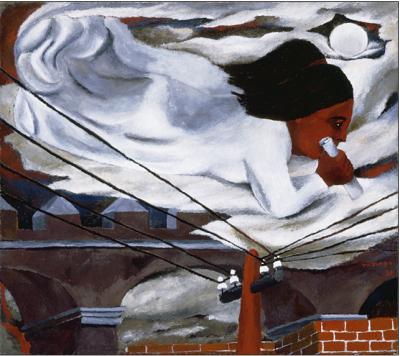I don’t usually think about weather. One of the luxuries of living in Los Angeles is the predictably warm temperature, but lately the weather has been weird, with fog followed by a burst of heat and then… thunderstorms? As unexpected grey rain clouds rolled by overhead last week and a flash flood warning appeared on my television, I thought of this Tamayo painting, Messengers in the Wind, which hangs in our Latin American art galleries. I love the urban detail of the telephone wires, the bricks and cement, combined with the magic of the two figures in flowing white robes sweeping past.
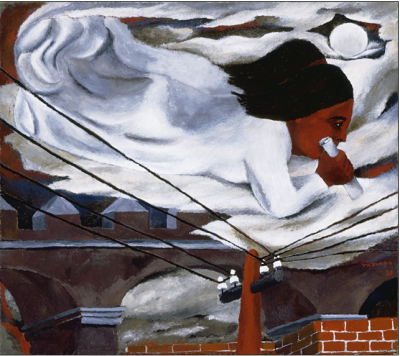
Rufino Tamayo, “Messengers in the Wind (Mensajeras en el viento),” 1931, The Bernard and Edith Lewin Collection of Mexican Art
The heat and humidity that followed made the Dutch paintings galleries in the Ahmanson Building a welcome respite. The weather in there, particularly the sky as painted by the great seventeenth-century painter Jacob van Ruisdael, is clearly from a cooler clime. A long wall of Ruisdael paintings feature dramatic and sometimes imposing skies, often making up the better part of his spectacular landscapes.
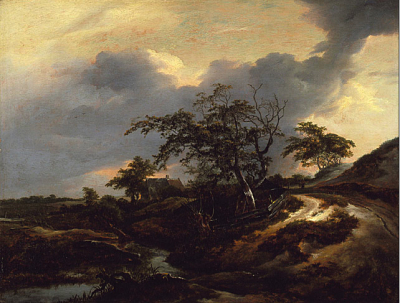
Jacob van Ruisdael, “Landscape with Dunes,” 1649, gift of Dorothy G. Sullivan
If you just turn to the wall to the left of the spectacular Ruisdaels, there’s a very different picture, Hendrick Avercamp’s Winter Scene on a Frozen Canal—one of my favorites in the museum. This scene of townspeople skating on a frozen canal in Holland perfectly captures the way the ice reflects the flat winter sky of northern places. All the warmth and color in the picture comes from the costumes of the characters zooming around on the ice, chatting, making money, and playing games.
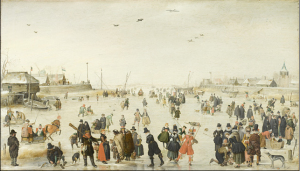
Hendrick Avercamp, “Winter Scene on a Frozen Canal,” c. 1620, partial gift of Mr. and Mrs. Edward William Carter and purchased with funds provided by The Ahmanson Foundation, the Paul Rodman Mabury Collection, the William Randolph Hearst Collection, the Michael J. Connell Foundation, the Marion Davies Collection, Mr. and Mrs. Lauritz Melchior, Mr. and Mrs. R. Stanton Avery, the Estate of Anita M. Baldwin by exchange, and Hannah L. Carter
For another wall of spectacular weather, I visited the newly installed Impressionist gallery at the south end of the Ahmanson Building, on the same floor as the Dutch galleries. Across from a wall of floor-to-ceiling windows hang a number of pictures by Monet including The Beach at Honfleur. In contrast to the moodier Ruisdael paintings, the sky here is crisp blue with innocuous white clouds high overhead, and the beach baking in the flat bright light of the coast.

Claude Monet, “The Beach at Honfleur, 1864–66, gift of Mrs. Reese Hale Taylor
If it’s possible to simulate weather through mechanical means, Thomas Wilfred does it for me with his Lumia light composition, Luccata Opus 182. I sat in front of the piece in the Ahmanson Building for a while. I’ve heard it described as “visual music.”
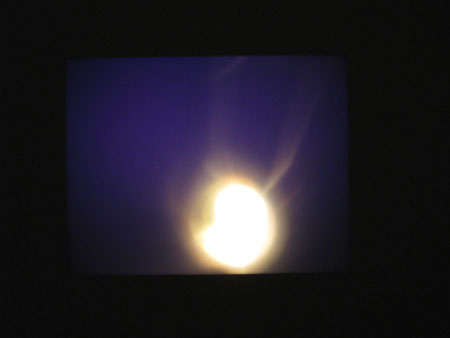
Thomas Wilfred, “Luccata, Opus 182," 1967–68, lent by Carol and Eugene Epstein, Los Angeles
In the shifting colors and shapes, I saw what reminded me of moonrise, the purple night sky of the desert, wisps of cloud and celestial bodies. The label for the piece refers to it as a “composition of infinite duration” and it struck me that the same could be said of the weather.



